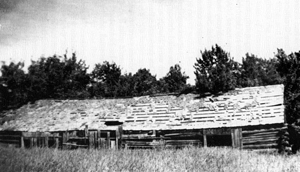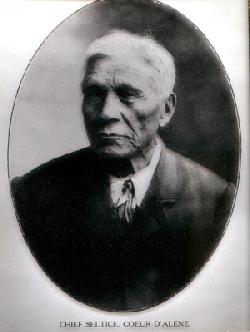|
||||
|
History: Honest and generous, Chief Seltice carved local legacy
6/6/2012 10:13:44 AM
By Ellen Martin Bernardo

Photo courtesy of Liberty Lake Historical Society
Coeur d'Alene Indian Chief Andrew Seltice lived for years in this home he built on the west side of Lake Seltice, which is now called the Saltese Flats. The log house with a rock fireplace was surrounded by barns and split-rail fences to care for his wealth of livestock and animals.
Liberty Lake Historical Society
French Canadian trappers and traders, coming through the area, began calling the Schitsu'umsh people they met "Coeur d'Alene," meaning "heart of the awl," as they had the reputation of being shrewd traders. The name stuck. The Schitsu'umsh people became known as the Coeur d'Alenes.
The prophecy of Chief Circling Raven, who ruled the Coeur d'Alenes for one hundred years, 1660 to 1760, foretold of the coming of the Black Robes, the Jesuit missionaries. This was fulfilled with the arrival of Father Pierre-Jean DeSmet in 1842. Andrew Seltice converted to Christianity in 1844 at the St. Joseph Mission. He was married to Julia Rosalia Tsjumskunnagwei at the same mission. The Black Robes and the mission would play a major role in the future of the tribe.
After the Northern Indian Wars of 1858, Chief Vincent, Andrew Seltice and other tribesmen quickly stepped forward to sign a peace and friendship treaty with the United States. They never again went to war against the U. S. government. However, this treaty did nothing to protect their ancestral lands. With the help of the Jesuits at the mission, the Coeur d'Alenes wrote letters asking for the government to honor their treaties and their tribal lands. It would take 43 more years to gain legal and binding title to their lands.
In 1865, Andrew Seltice, admired for his intelligence and wealth, became head chief, succeeding Chief Vincent. He was slow to anger and quick to make peace. His wealth came from his large herd of cattle and horses he raised. He was also known for his honesty, friendliness, courage and generosity.
He lived on the west side of Lake Seltice, now called Saltese Flats. Encouraged by Father Joseph Joset, Vice-Provincial of all Pacific Northwest missions, the Coeur d'Alene Indians set up permanent homes and farmed their land. Chief Seltice raised oats, wheat and vegetable crops. He had a large herd of cattle and hundreds of horses. He built the log house with a rock fireplace his family lived in, as well as barns and split-rail fences for his animals.
Chief Seltice's wife, Julia, mother of their 12 children, died in 1867. He married again the following year to Julia Marie Chenzie, daughter of Eugene and Juliana Tecomtee. Together, they had 11 children, making Chief Seltice the father of 23 children.
|
Genesis of Liberty Lake Did you know? • Andrew Seltice, Peter Wildshoe and Tecomtee were brothers-in-law. • The Cataldo Mission is the oldest standing building in Idaho. It replaced St. Joseph's Mission due to flooding. It served until the tribe's relocation to DeSmet. • One of the few among Chief Seltice's 23 children who lived to adulthood, Joseph Seltice, became a chief of the Coeur d'Alenes himself. • Chief Seltice was presented with a gold medal by President Grover Cleveland in 1887 when he came to Washington, D.C., with Steve Liberty, Peter Wildshoe, Regis, Louis Peone and Paul Alkin. During his lifetime, he also met Captain John Mullan, Col. George Wright, Col. Edward Steptoe and a governor. |
With help from the Jesuits, Chief Seltice helped bring the Coeur d'Alene's from a hunting and gathering society to an agricultural tribe. Before the 1850s, they gathered berries, dug camas bulbs and caught fish in the plentiful lakes, rivers and streams for their food. They hunted buffalo in Montana until the buffalo no longer were plentiful as well as mule deer and elk closer to home. By the 1850s, at least part of the tribe was farming.
Chief Seltice believed the way of life for his people had to change to survive with the influx of settlers. In the 1870s, they began to prepare for the move to an area that could sustain the entire tribe through agricultural means, not far from where they traditionally dug camas. The US government had still not given them title to their land. In 1877, Seltice moved to the DeSmet area of Idaho. He continued to keep his cattle and horses in the Spokane Valley area to graze and feed for a few more years as he developed his farm to fully support them.
Stephen Liberty, for whom Liberty Lake is named, became a friend of Chief Seltice. In 1887, Chief Seltice, his brother-in-law Peter Wildshoe, Stephen Liberty and others traveled to Washington, D.C., hoping for a treaty settlement. Again, it was not ratified. Liberty became a translator for the Coeur d'Alenes, traveling several times to Washington, D.C., on their behalf.
Chief Seltice invited Steven Liberty, Patrick Nixon, Joseph Peavy and Julian Boutelier and their families to be adopted as part of the tribe and to live on the reservation, which they accepted. They became known as "White Indians." Seltice also invited the Spokane Indians to settle on the Coeur d'Alene Reservation, too.
In 1891, the tribe finally received title to part of their ancestral lands now known as the Coeur d'Alene Indian Reservation. It took until June 2, 1924, for a law to be passed allowing the American Indians to become citizens in their own country.
After serving his beloved people as chief for 37 years, Chief Andrew Seltice died on April 20, 1902. He was buried at the church cemetery overlooking the DeSmet Mission.
Ellen Martin Bernardo is vice president of the Liberty Lake Historical Society. She has lived in the Inland Northwest 33 years, 23 of those in Liberty Lake.



